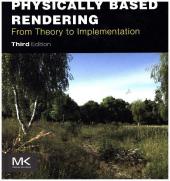 Neuerscheinungen 2016Stand: 2020-02-01 |
Schnellsuche
ISBN/Stichwort/Autor
|
Herderstraße 10
10625 Berlin
Tel.: 030 315 714 16
Fax 030 315 714 14
info@buchspektrum.de |

Greg Humphreys, Wenzel Jakob, Matt Pharr
(Beteiligte)
Physically Based Rendering
From Theory To Implementation
3. Aufl. 2016. 1266 S. 235 mm
Verlag/Jahr: MORGAN KAUFMANN 2016
ISBN: 0-12-800645-5 (0128006455)
Neue ISBN: 978-0-12-800645-0 (9780128006450)
Preis und Lieferzeit: Bitte klicken
Physically Based Rendering: From Theory to Implementation, Third Edition , describes both the mathematical theory behind a modern photorealistic rendering system and its practical implementation. Through a method known as ´literate programming´, the authors combine human-readable documentation and source code into a single reference that is specifically designed to aid comprehension. The result is a stunning achievement in graphics education.
Through the ideas and software in this book, users will learn to design and employ a fully-featured rendering system for creating stunning imagery. This completely updated and revised edition includes new coverage on ray-tracing hair and curves primitives, numerical precision issues with ray tracing, LBVHs, realistic camera models, the measurement equation, and much more. It is a must-have, full color resource on physically-based rendering.
Presents up-to-date revisions of the seminal reference on rendering, including new sections on bidirectional path tracing, numerical robustness issues in ray tracing, realistic camera models, and subsurface scattering
Provides the source code for a complete rendering system allowing readers to get up and running fast
Includes a unique indexing feature, literate programming, that lists the locations of each function, variable, and method on the page where they are first described
Serves as an essential resource on physically-based rendering
1. Introduction 2. Geometry and Transformations 3. Shapes 4. Primitives and Intersection Acceleration 5. Color and Radiometry 6. Camera Models 7. Sampling Reconstruction 8. Reflection Models 9. Materials 10. Texture 11. Volume Scattering 12. Light Sources 13. Monte Carlo Integration 14. Light Transport I: Surface Reflection 15. Light Transport II: Volume Rendering 16. Light Transport III: Bidirectional Methods 17: Retrospective and the Future
" Physically Based Rendering is a terrific book. It covers all the marvelous math, fascinating physics, practical software engineering, and clever tricks that are necessary to write a state-of-the-art photorealistic renderer. All of these topics are dealt with in a clear and pedagogical manner without omitting the all-important practical details." --Per Christensen, Senior Software Developer, RenderMan Products, Pixar Animation Studios
"This book has deservedly won an Academy Award. I believe it should also be nominated for a Pulitzer Prize." --Donald Knuth


